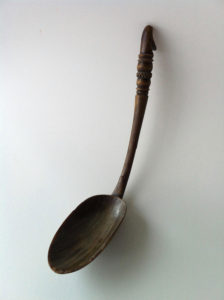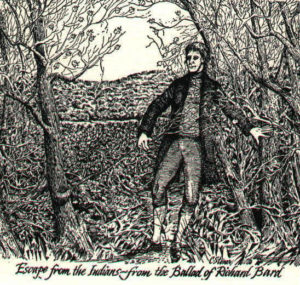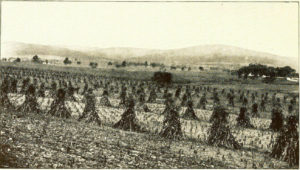Richard Bard Rescues His Wife
by James Rada, Jr.
Editor’s Note: This is the third in a series of columns about Richard Bard’s escape from captivity and the rescue of his wife.
After the Delaware Indians had captured the Bard Family in 1758, Richard Bard managed to escape his captivity after a few days. His wife, Catherine, wasn’t so lucky. She remained a prisoner of the Indians.
The Delawares initially beat her, but once the war party arrived back in their village, two braves adopted Catherine as a sister. “She was treated during this time by her adopted relations with much kindness, even more than she had reason to expect,” Catherine’s son, Archibald, wrote in Incidents of Border Life.
In the meantime, Richard Bard recovered from his ordeal and began hunting for his wife. The Indians had already killed one of his children, and he wasn’t going to lose his wife. “From the time that my father was taken by the Indians until my mother was released, he did little else than wander from place to place in quest of information respecting her and after he was informed where she was his whole mind bent upon contriving plans for her redemption,” Archibald wrote.
Bard traveled to Fort Duquesne in the fall of 1758. A treaty had been signed with the Indians there, and Bard went to meet with them to ask about his wife to see if he could find out where she had been taken.
Some of these Indians were the ones who had raided Bard’s mill and captured him, his family, and friends. “My father observed among them several who were there when he was taken prisoner, to these he discovered himself they professed not to know him on which he enquired of them they did not recollect having been at the taking of nine persons referring them to the time and place,” Archibald wrote.
When Bard left the Indians and returned to Fort Duquesne, he was followed by a young man. The man told Bard that after he had gone, the Indians had said “that they never had a stronger desire for anything than to have sunk the tomahawk into his head, and that they had agreed to kill him on his return next day,” according to Archibald. The young Indian warned Bard not to return the next day if he wanted to live.
Instead, Bard chose to travel with a wagon convoy to Fort Bedford, where he met an Indian named Captain White Eyes, who was friends with the Moravian missionaries in the area. A few miles from Fort Bedford, the Indians with the convoy got drunk. One of the wagon drivers was scalped, and Bard was once again captured.
“Captain White Eyes was soon under the influence of liquor, and told Bard if he tried to escape, he would be shot. He told Bard that he knew that he had escaped from the Delawares before,” wrote L. Dean Calimer in Franklin County Archives VII. White Eyes fired at Bard, but he jumped behind a tree. Bard then moved around the tree to keep it between himself and the Indian. The other Indians found this amusing, until one of them finally grew tired of it and disarmed White Eyes.
White Eyes then grabbed a stick and began beating Bard, but Bard managed to make his way to a horse and escape.
Following up on information about his wife being at the Indian village of Shamokin (Sunbury, Pennsylvania), Bard made his way to Pittsburgh. He wrote a letter to his wife, saying that if her adopted friends would bring her to Pittsburgh and release her, he would pay 40 pounds. Bard was hoping that even if they didn’t release her, some other Indians would hear about the reward offer and find a way to free her.
While the Indians who had adopted Catherine Bard were willing to free her, they feared that they wouldn’t be paid the bounty.
“To allay their suspicions he told them to keep him as a hostage, while they sent Mrs. Bard into the town with an order for the money. This put the savages in good humor, and they took them into the town, where the money was paid and his wife was released,” Calimer wrote.
Catherine had been a captive of the Delawares for two years and five months.
Following her release, the Bards returned to Franklin County and bought a plantation near Williamson.
Bard went on to serve in the Revolutionary War. He was also a member of the Pennsylvania Convention in 1787, which was the group of Pennsylvanians who were asked to ratify the U.S. Constitution in the Commonwealth.
He died in 1799. He is buried in the Church Hill Graveyard in Mercersburg, Pennsylvania.
Catherine kept one memento—if you can call it that—of her time among the Delawares. It is a horn spoon that was given to her to help her in her work as a woman of the tribe. It was passed down through the females of the family.
One interesting post-captivity story is that one of Catherine’s “brothers” came to visit the Bards. While there, he went to a tavern and got a bit drunk. He was attacked by a white man who tried to kill him, but only severely wounded him.
According to the book, The Bard Family, “The Indian was cared for at Mr. Bard’s house until he recovered, but he was afterward put to death by his tribe on the pretense that he had joined the white people.”
Catherine died in 1811. She is buried in the Church Hill Graveyard with her husband.
 Captured and forced to stay with the Delawares tribe for over two years, Catherine Bard kept one memento of her time with the Delawares, a horn spoon, given to her to help her in her work as a woman of the trible.
Captured and forced to stay with the Delawares tribe for over two years, Catherine Bard kept one memento of her time with the Delawares, a horn spoon, given to her to help her in her work as a woman of the trible.



